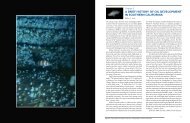checklist (pdf) - The Love Lab - University of California, Santa Barbara
checklist (pdf) - The Love Lab - University of California, Santa Barbara
checklist (pdf) - The Love Lab - University of California, Santa Barbara
Create successful ePaper yourself
Turn your PDF publications into a flip-book with our unique Google optimized e-Paper software.
Arctoscopus japonicus (Steindachner, 1881). Sailfin Sandfish. To 16.8 cm (6.6 in) SL (Amaoka et al. 1995).<br />
Yellow Sea and Japan Sea <strong>of</strong>f Korea to Okhotsk Sea, Kuril Islands (Lindberg and Krasyukova 1969), and<br />
Pacific coast <strong>of</strong> Hokkaido (Hatooka in Nakabo 2002); one record from Akutan Bay, Aleutian Islands<br />
(Mecklenburg et al. 2002). Bottom at depths <strong>of</strong> 100–400 m (328–1,312 ft) (min.: Hatooka in Nakabo<br />
2002; max.: Amaoka in Masuda et al. 1984), except spawning on seaweed beds at depths <strong>of</strong> about 2–<br />
10 m (7–33 ft; Amaoka in Masuda et al. 1984). <strong>The</strong> one A. japonicus recorded from Alaska could be a<br />
fish that drifted unusually far after hatching before it settled to the bottom, but recent records from the<br />
northern Okhotsk Sea indicate A. japonicus may not be as rare north <strong>of</strong> Japan as authors have believed<br />
it to be (Mecklenburg 2003).<br />
Trichodon trichodon (Tilesius, 1813). Pacific Sandfish. To 30.5 cm (12 in) TL (Miller and Lea 1972). Japan to<br />
Kuril Islands (rare), southeastern Kamchatka, and Commander–Aleutian chain to southeastern Bering<br />
Sea, including Pribil<strong>of</strong> Islands (Mecklenburg et al. 2002), to San Francisco, northern <strong>California</strong> (Miller<br />
and Lea 1972). Intertidal area, where it is <strong>of</strong>ten found buried in the sand after a receding tide (e.g., Lamb<br />
and Edgell 1986), and to reported depth <strong>of</strong> 375 m (1,230 ft) but usually found shallower than 150 m<br />
(492 ft; Allen and Smith 1988). Greatest depth we found from museum specimens is 172 m (564 ft; UW<br />
26863).<br />
Family Ammodytidae — Sand Lances<br />
Ammodytes hexapterus Pallas, 1814. Pacific Sand Lance or Stout Sand Lance. To 28 cm (11.0 in; Mecklenburg<br />
et al. 2002). Sea <strong>of</strong> Japan to Aleutian Islands, Bering Sea, and western Canadian Arctic (Mecklenburg et al.<br />
2002) to Balboa Island, southern <strong>California</strong> (Miller and Lea 1972). School near surface to fairly shallow<br />
depths and rest buried in substrate; intertidal and to 100 m (330 ft) (min.: Eschmeyer and Herald 1983;<br />
max.: Allen and Smith 1988), reported to 172 m (564 ft; W. A. Palsson, pers. comm. to M. L.).<br />
*Ammodytoides gilli (Bean, 1895). Panamic Sand Lance or Silver Sand Lance. To 13.5 cm (5.3 in) TL<br />
(Robertson and Allen 2002). Cabo San Lucas, southern Baja <strong>California</strong> (Collette and Robertson 2001)<br />
and central Mexico to Ecuador, including Islas Galápagos (Robertson and Allen 2002). At depths <strong>of</strong><br />
1–25 m (3–82 ft) (min.: Robertson and Allen 2002; max.: Collette and Robertson 2001).<br />
Family Uranoscopidae — Stargazers<br />
Astroscopus zephyreus Gilbert & Starks, 1897. Electric Stargazer, Pacific Stargazer, or Zephyr Stargazer. To<br />
52 cm (20.5 in) TL (Jesus-Roldan et al. 1993). Huntington Beach, southern <strong>California</strong> (Jesus-Roldan et<br />
al. 1993) to Chimbote, Peru (Chirichigno and Vélez 1998), including Gulf <strong>of</strong> <strong>California</strong> (Jesus-Roldan<br />
et al. 1993). At depths <strong>of</strong> 7–385 m (23–1,263 ft) (min.: Godinez-Dominguez et al. 2000; max.: Robertson<br />
and Allen 2002).<br />
Kathetostoma averruncus Jordan & Bollman, 1890. Smooth Stargazer. To 32 cm (12.6 in) TL (Bussing and<br />
Lavenberg in Fischer et al. 1995). Piedras Blancas Point, central <strong>California</strong> (Fitch and Lavenberg 1968)<br />
to Isla Lobos de Tierra, Peru (Chirichigno 1974), including mouth <strong>of</strong> Gulf <strong>of</strong> <strong>California</strong> (Robertson<br />
and Allen 2002) and Islas Galápagos (Grove and Lavenberg 1997). At depths <strong>of</strong> 13–600 m (42–1,968 ft)<br />
(min.: Miller and Lea 1972; max.: Robertson and Allen 2002).<br />
Family Tripterygiidae — Triplefins<br />
*Axoclinus nigricaudus Allen & Robertson, 1991. Cortez Triplefin. To 4.5 cm (1.8 in) TL (Allen and<br />
Robertson 1994). Gulf <strong>of</strong> <strong>California</strong> to Cabo San Lucas, southern Baja <strong>California</strong> (Watson in Moser<br />
1996). Intertidal (Allen and Robertson 1994) and to 5 m (17 ft; Robertson and Allen 2002). Classified by<br />
some authors in Enneanectes; see review <strong>of</strong> taxonomic status in Smith and Williams (2002).<br />
151




